

History is the study of change over time. Many things influence change, such as geography, weather, natural resources, and people. The story of how those changes affected humans and the area around them creates a foundation for understanding Palm Beach County today. Changes affecting humankind were recorded in a variety of ways. When humans began to communicate through language, they started telling stories of past events. These stories continue through folk tales, family reminiscences, art (from cave drawings to computer graphics), and music, including songs and dances.
When communication moved to the next step, writing, the stories lasted longer and could outlast the individual. No longer was it necessary to rely on one person’s or group’s memory, nor was it as easy to have the stories changed through exaggerations. This is not to say that written history is always correct. After all, history is written through the point of view of the person writing it and reflects the times he or she lives in. History should be regarded with that in mind. The facts might be correct, but the person interpreting them probably reflects the opinions and attitudes of the era.
How, you might wonder, do we know about what occurred before people could pass along the oral stories or write them down? Many sciences contribute to the knowledge relating to pre-history. Through archaeology, we learn about previous cultures by interpreting the relics they left behind in villages, trash heaps, and grave sites. Geology helps explain the changes that the earth’s surface has experienced because of natural disasters and climactic changes to the landscape.
To understand Palm Beach County’s past and its present, one must learn about the geography, people, places, and events that have shaped it. By learning more about the “days of yore,” you will see connections between the past and the present. You will be able to form your own conclusions about those links and to make predictions about the future. The story of Palm Beach County begins with the land.
FLORIDA'S GEOGRAPHIC LOCATION
Florida is the southeastern-most state in the United States. It is a peninsula, because it is surrounded by water on three sides. To the east is the Atlantic Ocean, to the west is the Gulf of Mexico, and to the south is the Straits of Florida, the channel of water between the Florida Keys and Cuba. The states that border Florida to the north are Alabama and Georgia.
Florida has a distinctive shape that makes it easy to locate on a map. The northwestern part of the state is called the Panhandle, because it is shaped like the handle of a frying pan. Two important cities in the Panhandle are Pensacola and Tallahassee, the state capital. At the tip of southern Florida rests a string of islands called the Florida Keys. The most famous of these islands are Key Largo, Marathon, and Key West.
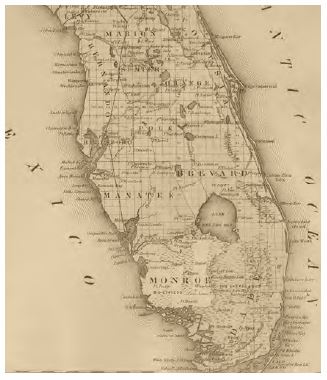
THE LAND
Between 300 and 400 million years ago, north Florida was separated from swampy south Florida by a body of water called the “Florida Trench.” The activity of volcanoes some 200 million years ago filled in the trench, leaving only a shallow sea. Then sand and shells of dead marine animals fossilized to form an area of flat land, or limestone plateau. This flat area is slightly raised above the neighboring land and finally rose upward, forming a marshy plain at sea level.
During an ice age, about one hundred million years ago, the water level of the ocean dropped due to water captured in glaciers. For thousands of years, Florida was actually twice its present size. When the last ice age ended, about 12,000 years ago, the ocean levels rose again, and the climate became warmer and wetter. Part of Florida remained underwater; today, it is called the “continental shelf.” This shelf slopes gently into the ocean. Where it ends, the water becomes very deep. Over time, the constant rising and falling of the water levels helped form the three land regions that currently exist in Florida: the Atlantic Coastal Plain, the Florida Highlands, and the Gulf Coastal Plain.
Today, Florida has several types of landscapes: lowlands, highlands, and wetlands. The lowlands are flat and are less than fifty feet above sea level. These areas are found at the Atlantic Coastal Plain and the Gulf Coastal Plain. Flat grasslands, called “savannas”, cover much of this land. Barrier islands are also common in Intracoastal Waterway is one example; it passes along the east coast of Florida and stretches from Maine to Texas. This waterway separates the mainland of Florida from the various barrier islands.
The Everglades, an area of wetlands in south Florida, is home to many plant and animal species. This land is made up of sawgrass, prairies, mangrove swamps, and hammocks. The Everglades is low and flat, and only eight feet above sea level at its highest point. Before significant man-made changes were made to the south Florida landscape, the Everglades covered the northernmost reaches of Lake Okeechobee. Many animals make their homes in this unique territory, including many types of birds, mammals, alligators, and crocodiles. Unfortunately, humans have drained large sections of the Everglades; doing so has disturbed these animals’ ecosystem. Today, there is a movement to restore the Everglades to its former pristine condition.
CLIMATE
Florida has a mild climate, so no drastic temperature changes occur throughout the year. The southern tip of Florida is near the equator, which explains its warm temperatures. However, areas farther north, such as the Panhandle, do experience colder temperatures. In fact, the record low temperature for the state is -2 degrees Fahrenheit, recorded in Tallahassee on February 13, 1899. Overall, Florida’s mild climate is good for growing crops and allows for participation in warm-weather activities all year long.
In addition to its mild temperatures, Florida is known for its wetness. Precipitation averages more in Florida than in most other states. The rainy season begins in May and ends in October. Thunderstorms, tornadoes, tropical storms, and hurricanes characterize this season. Florida residents pay close attention to the meteorologist’s forecasts during these threatening months, and they often prepare ahead of time, in case a major storm heads their way.
For the most part, Florida’s climate attracts many people. Some simply enjoy visiting. Others live here during the winter months, then return north for spring and summer. These people are sometimes called “snowbirds” by year-round residents.
PALM BEACH COUNTY GEOGRAPHY
he county is one of sixty-seven counties in Florida, and is on the southeast coast of the state. Southeast Florida includes Martin, Palm Beach, Broward, and Miami-Dade counties and covers approximately 10,818 square miles (both land and water area). Palm Beach County is bordered by Martin County on the north, Broward County on the south, and the Atlantic Ocean on the east. The western boundary of the county is created by Hendry County and Lake Okeechobee. Large areas of Palm Beach County include wildlife management areas, such as the Arthur R. Marshall Loxahatchee National Wildlife Refuge, which is part of the north end of the Everglades and covers 221 square miles, or 147,368 acres.
Broward and Miami-Dade counties are more urbanized than Palm Beach County, because large parts of the central and western areas of Palm Beach County are nature preserves and agricultural areas. Urban development has been confined largely to the eastern areas of the county, along the coast, and spreading west about 20-25 miles inland. In addition, there are communities along the east shore of Lake Okeechobee.
Palm Beach County is one of the largest counties east of the Mississippi River, covering approximately 2,248 square miles (land and water area). The county is larger than each of the states of Rhode Island (1,214 sq. mi.) and Delaware (1,982 sq. mi.). According to the 2010 Census, 1,320,134 people live in the county. Palm Beach County is one of the fastest growing counties in Florida. About 55% of its residents live within its thirty-nine municipalities. The remaining 45% live in unincorporated areas of the county. The largest city is West Palm Beach, with a population over 102,455 (2015 estimate). The northernmost community is Tequesta, the southernmost is Boca Raton, and the westernmost is South Bay.
Barrier Islands and Waterways
Along the coast is a series of barrier islands that help protect the mainland from pounding waves and storms. The barrier islands all have established communities on them. During hurricanes, the human population on these islands is evacuated to the mainland.
A channel called the “Intracoastal Waterway” runs between the mainland and these islands. This channel runs the length of Florida north to Maine. The once land-locked Lake Worth is now part of this waterway.
The Loxahatchee River, in Jupiter, is about eight miles long and flows through Jupiter Inlet. Four of the largest lakes in Palm Beach County are Lake Okeechobee, 67,200 acres; Lake Mangonia, 540 acres; Clear Lake, 401 acres; and Lake Osborne, 356 acres. There are numerous other lakes, both man-made and natural, and streams in the county. Four major canals from Lake Okeechobee to the Atlantic Ocean cut through the county: the Miami Canal, North New River Canal, Hillsboro Canal, and West Palm Beach Canal.
Four inlets enter the Intracoastal Waterway through the barrier islands: Jupiter Inlet, Lake Worth Inlet, Boynton Beach Inlet, and Boca Raton Inlet.
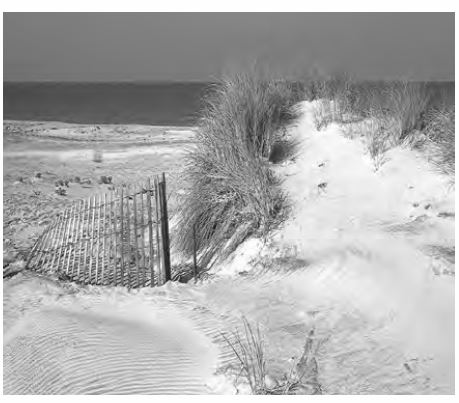
HURRICANES
Weather is a concern for residents and visitors, especially during the hurricane season, which runs from June 1 through November 30 each year. A hurricane is a large storm, rotating in a counter-clockwise motion. The storms that create hurricanes form over the warm waters of the Atlantic Ocean as they head west from Africa. These disturbances, or tropical waves, gain strength as they move westward toward the Caribbean Sea. As a tropical wave encounters a low-pressure area, it begins to spin, turning into a tropical depression. Tropical depressions have wind speeds of less than forty miles per hour at the surface. When the winds reach forty miles per hour or more, the depression becomes a tropical storm.
When the winds reach seventy-four miles per hour, the storm becomes a hurricane, with an eye at its center, an area of calm winds and low pressure. The eye is surrounded by a cloud called an “eye wall” which contains thunderstorms, high winds, and rain. “Tropical cyclone” is the generic name for a hurricane. When these storms occur in the Pacific Ocean, they are called “typhoons.” In the Indian Ocean and the South Pacific, they are referred to as “cyclones.” All tropical storms and hurricanes are assigned names.
Although several hurricanes have struck since the 1940s, none has caused as much loss of life and property damage as did the 1928 hurricane. In 1992, however, Hurricane Andrew caused more than $30 billion in damages in south Florida. Consequently, building regulations have become more stringent all over the state. Builders are required to use the latest in safety design. Evacuation routes have been established for those living along the coast. Through science and computers, meteorologists keep the public well informed if a hurricane is approaching Florida. This allows people to prepare.
In August and September 2004, Florida was struck by four hurricanes. Hurricane Charley hit the southwest coast and cut a path to the northeast Florida coast; then Hurricane Frances struck Palm Beach, Martin, and St. Lucie counties and headed northwest through Florida; next, Hurricane Ivan devastated the Panhandle area of Florida; finally, Hurricane Jeanne hit the same areas as Hurricane Frances. These hurricanes caused billions of dollars in damages. The last time Florida had been hit by three hurricanes within weeks of each other was in 1964.
How Hurricanes Affected The Land Boom and Bust
Hurricanes affected the growth of Florida. In the early 1920s, there was a period of prosperity here. People thought they could get rich buying land in the state. However, after the 1926 hurricane destroyed property in south Florida, people were afraid to purchase land. Consequently, land developers and investors lost their money as land sales dropped. Many of the millionaires created by the land boom went broke. This hurricane was followed two years later by an even worse one.
On September 16, 1928, a Category 4 hurricane struck Palm Beach County. It came ashore with winds of 130 to 150 miles per hour, and dropped more than eighteen inches of rain in less than twenty-four hours. It damaged or destroyed almost everything in its path. The strong winds and heavy rainfall caused Lake Okeechobee to overflow and to flood Belle Glade, Pahokee, and South Bay. Flooding and high winds killed more than 3,000 people in the Glades. However, the survivors overcame the disaster and rebuilt their cities and towns. Because of this disaster, the Hoover Dike was built around Lake Okeechobee to prevent another tragedy.
Economic hardship and several natural disasters that struck south Florida led the state into a depression. In October 1929, Palm Beach County was still recovering from the 1928 hurricane when the New York Stock Market crashed, causing the nation to enter the Great Depression, a time of economic hardship. Throughout the county, banks closed, and people lost their hard-earned money and jobs as businesses failed. There would not be a great recovery for the nation until World War II. (Benchmark: SC.7.E.6.6)
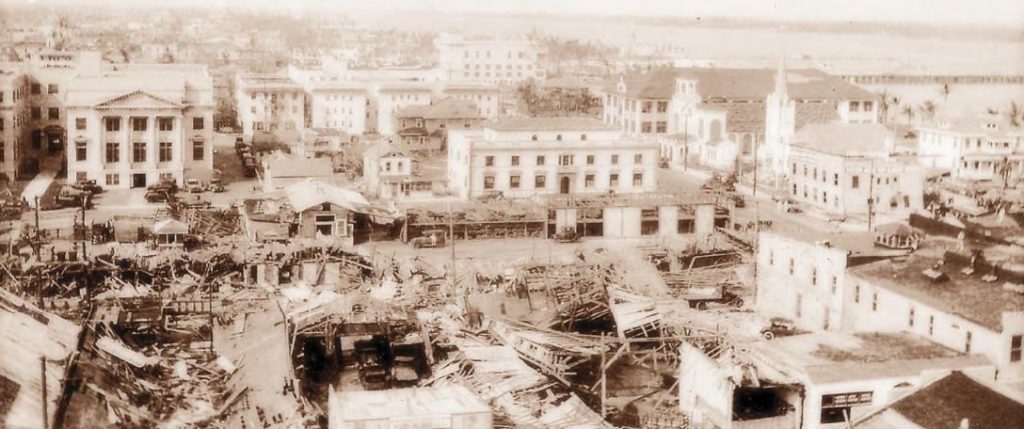
LAKE OKEECHOBEE AND THE DIKE
Lake Okeechobee, whose name comes from a Seminole word meaning “big water,” forms part of the western border of Palm Beach County. When the Spanish arrived in Florida, the lake had been known as “Mayaimi”. The Europeans called it such names as Espiritu Santo Laguna, Lake Mayaca, Lake Macaco, and Lake Sarrope.
Okeechobee is the second largest freshwater lake in the continental United States. It averages forty-five miles across,
its diameter. It covers more than 730 square miles and is ten to fourteen feet deep. Water that flows from the southern shore of the lake once provided fresh water to the Everglades, flowing south to Florida Bay and southwest to the Gulf of Mexico. In the 1920s, however, people changed the natural flow of the water.
The hurricanes of 1926 and 1928 caused terrible flooding in south Florida. To prevent future flooding, President Herbert Hoover approved a plan for an earthen dike to be built around Lake Okeechobee, which took thirty-eight years to build. Early construction on the dike provided work to many people who had lost their jobs because of the Great Depression. Today, Lake Okeechobee is completely surrounded by 151 miles of dike. It protects the county’s rich farmlands from flooding.
Though the Hoover Dike has helped to protect the area from floods, it has created environmental problems. The dike stopped the normal flow of water that helped supply nutrients to the muck soil, and water to the Everglades. Farmers had to begin using fertilizers to replace the missing nutrients, but water runoff from the fertilized fields flowed into the Everglades. This was
a problem because fertilizers harm the plants and animals that grow and live there.
These and other environmental problems have brought about changes. The Comprehensive Everglades Restoration Plan (CERP) is a project to restore the Everglades and Lake Okeechobee to something resembling its natural state. This includes making stormwater safe, saving the wetlands
and teaching others how to take care of their environment. Restoration of the lake and the Everglades will allow for even more tourism and recreation. In the future, this project will benefit nature and people.
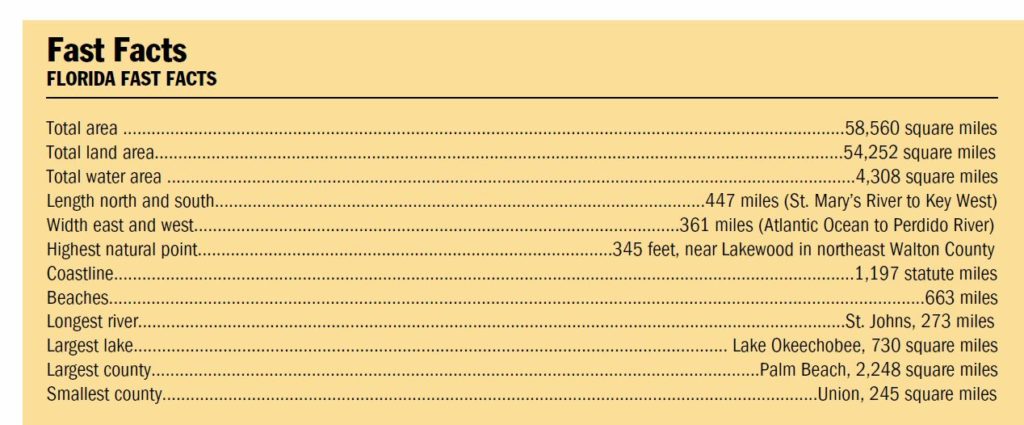
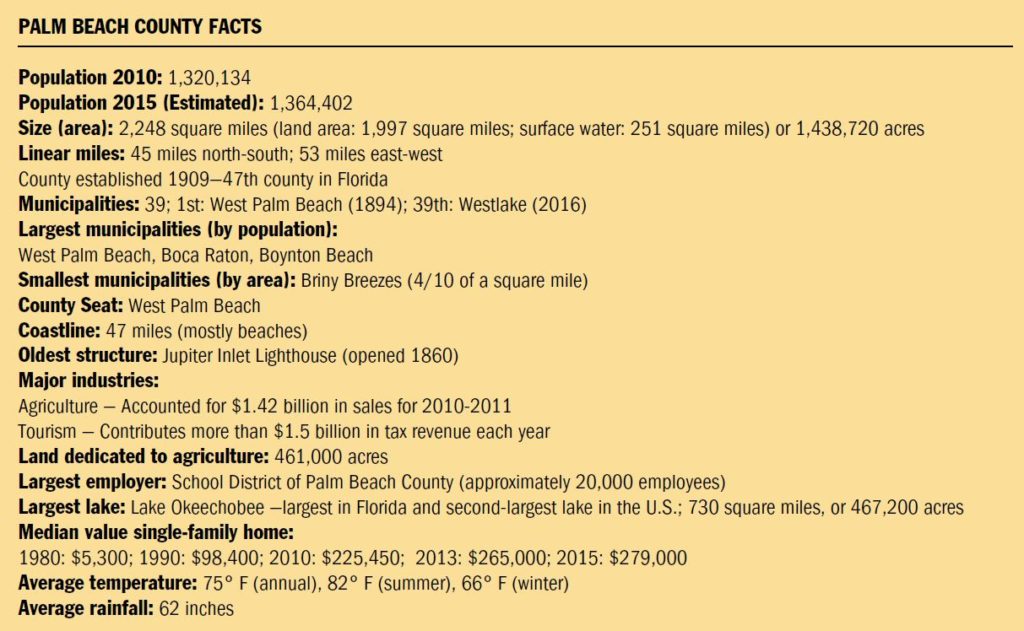

Why is it important to study history?
- What factors have influenced change?
- Why does Florida have a mild climate?
- Palm Beach County is larger than which two U.S. states?
- What were some contributing factors that led to the 1920s Florida Land Bust?
- List three ways
you communicate with people. Briefly explain which is your favorite, and why. - Why are some people asked to evacuate their homes when a hurricane is about to hit?
- List and explain the positive and negative consequences of having a dike that surrounds Lake Okeechobee.
- Choose one of the land forms mentioned in this section, draw a picture of it, and write a brief description of it.
- Get a tropical storm/hurricane-tracking map and begin tracking storms.
- Note the benefits and the problems associated with the Lake Okeechobee dike.
While you read, use a map to locate and identify the areas discussed in this section.
- Do you live east or west of Interstate 95?
- When people go to the beach on the east coast of Florida, what ocean are they swimming in?
- Briefly explain why Florida is hit with more hurricanes and tropical storms than non-coastal states.
